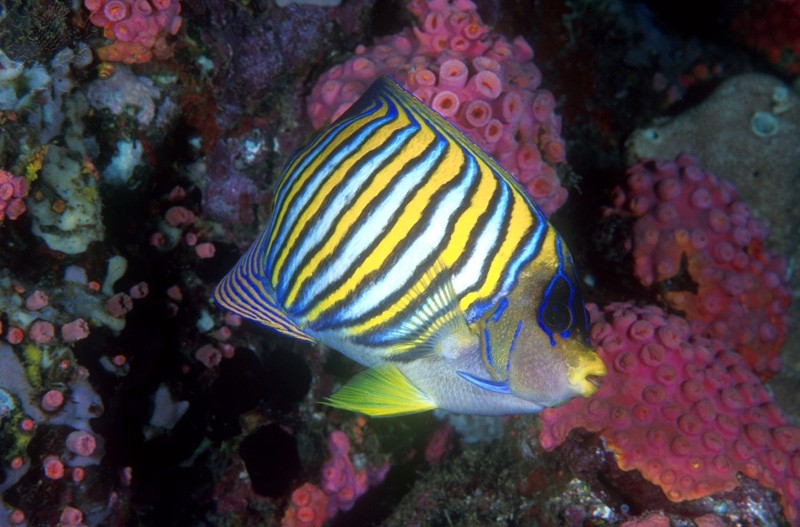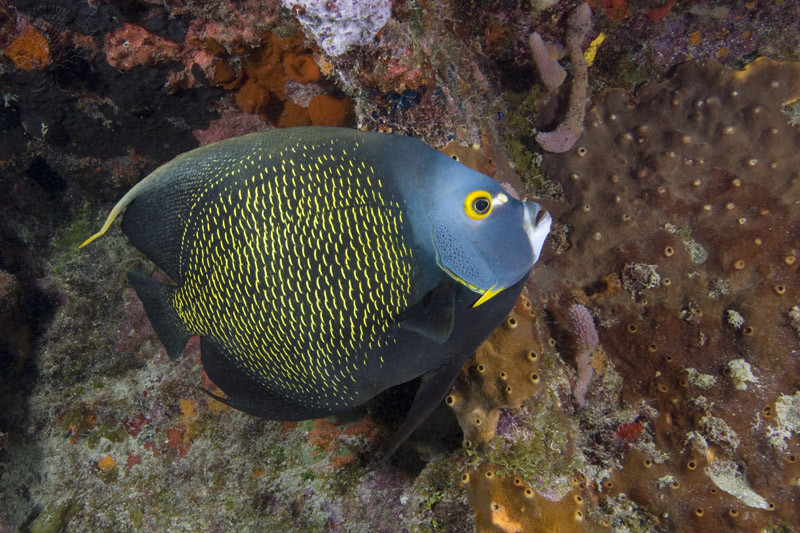Angelfish
By: Sophie Koren

Description
The Angelfish is a secretive type of fish in the pomacanthidae family. Angelfish have thin, oval bodies, small mouths, somewhat large pectoral fins, rounded to crescent shape tail fins and have long, pointed fins. On their bodies, angelfish have different series of patterns and strips of colour. For example, the Three-spot Angelfish has a yellow body, blue lips and a black spot on its forehead and as for the Regal Angelfish, it has yellow and white alternating bars, with a fine black line separating the two colours on its body. Angelfish can be as small as 10 cm and can grow as large as 60 cm. The Coral Beauty is one of the smallest species of Angelfish that grows to about 10 cm and the Grey Angelfish is one of the largest species that can reach 60 cm.
 Habitat
Habitat
Angelfish mostly inhabit the warm coral reefs, tropical seas and marine waters. They can also be found in lagoons reef slopes and dropoffs. Angelfish are seen in pairs, small groups and also as solitary individuals, for example the Biocolor Angelfish is seen singly, in pairs and in small groups. Angelfish are found in depths of 1 m to around 50 m, but the Ballina Angelfish is found in depths from 15 m to 120 m.
Predator Adaptations
Angelfish have small mouths and therefore can only eat small creatures. The majority of angelfish such as Three-spot Angelfish, Biocolor Angelfish, Coral Beauty Angelfish, Pearlscale Angelfish and Vermiculated Angelfish do eat algae, but they don't only eat algae. Some types of angelfish eat small crustaceans, sea sponges, sea squirts, plankton, salps and worms. For example, the Vermiculated Angelfish feeds on algae, sea sponges, sea squirts and salps.
Prey Adaptions
Angelfish are not known for their camouflage techniques so one of their only hopes to survive is to be quick. They must be fast enough to escape from sharks, crocodiles, alligators, birds and some larger fish. Being fast is not the only thing that keeps these beautiful fish alive, they also havean intimidation factor. Angelfish travel in either pairs, small groups or as solitary individuals. It is more intimidating for Angelfish predators to attack a school of fish than to attack a single fish.

Symbiotic Interactions
Angelfish don't interact with many species of different kind, but they do have commensalistic symbiotic relationship with coral polyps. Although the Angelfish does not do anything to help the Coral Polyps, coral Polyps make a perfect shelter for angelfish to live in the caves.
Comparison with (Butterflyfish)
Similarities
The Angelfish and the Butterflyfish are marine cousin from the pomacanthidae and chaetodontidae family. They can be easily confused because both, angelfish and butterflyfish, have intricate patterns and bright colours on their bodies.
Differences
Although the Angelfish and the Butterflyfish look very much alike, there are some differences. The Butterflyfish has a longer cone shaped snout compared the Angelfish with a shorter and smaller mouth. Angelfish are found mostly alone, in pairs or in small school and butterflyfish are usually found in larger schools. While some angelfish can grow to 60 cm, the largest a butterflyfish can grow is 30 cm.
Resources
Mark McGrouther , Collection Manager, Ichthyology. 27 May 2013
http://www.australianmuseum.net.au/Pomacanthidae-Angelfishes/
Pomacanthidae. Wikipedia. 25 May 2013.
http://en.wikipedia.org/wiki/Pomacanthidae
Royal Angelfish. Photograph. Encyclopædia Britannica Image Quest Web. 25 May 2013.
http://quest.eb.com/images/106_934339
Hixon, MA 2013, 'Angelfish' , World Book Student, World Book, Chicago, viewed 25 May 2013,
<http://www.worldbookonline.com/student/article?id=ar021640>.
School Of Angelfish. Photograph. Encyclopædia Britannica Image Quest. Web. 27 May 2013.
http://quest.eb.com/images/139_1901815
French Angelfish. Photography. Encyclopædia Britannica Image Quest. Web. 3 Jun 2013
.http://quest.eb.com/images/149_2103198
Amanda S. Butterflyfish. Darwin's Reef Exploration Team. 3 June 2013
http://darwinsreef.pbworks.com/w/page/66229874/Butterflyfish
Comments (0)
You don't have permission to comment on this page.